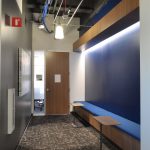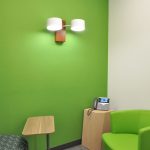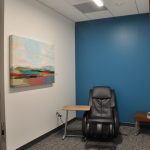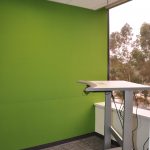Can “Free Address” Work Environments Create a Sense of Place?
By Angela Ball
Date
January 16, 2020“Free address” workspaces in which employees no longer have a permanent desk space are becoming increasingly popular. In this system, occupancy sensors are tied to each workstation to track which ones are occupied each day. Employees can track and reserve their spot for the day through a software application and view the seating assignment on monitors throughout the office.
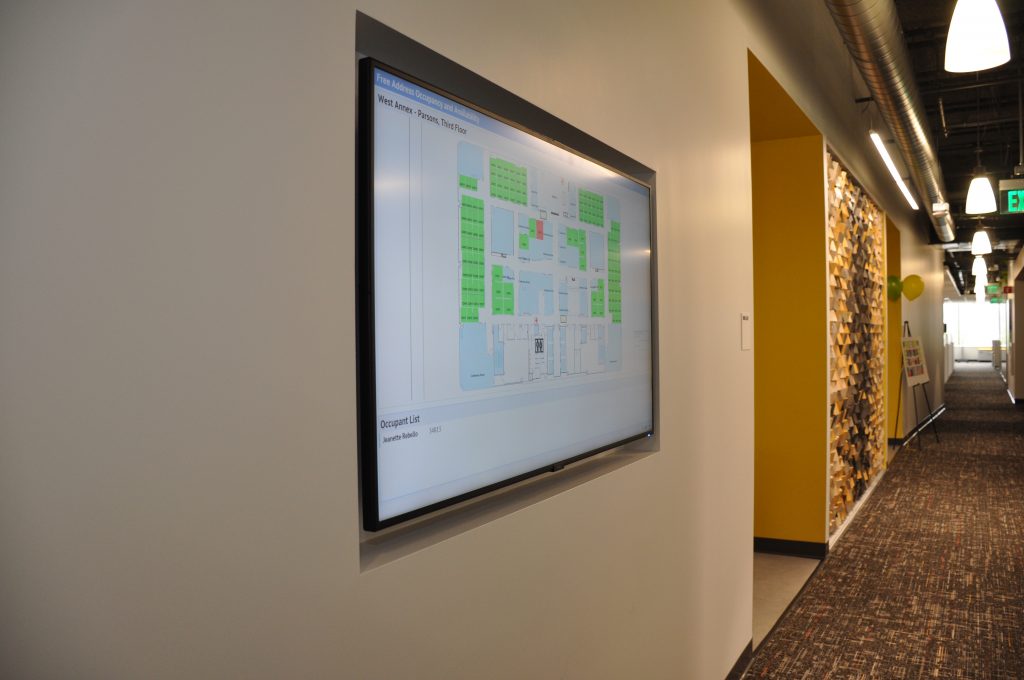
Employees can track available seating on monitors throughout the office.
According to CBRE’s 2018 Americas Occupier Survey, “52% of respondents anticipate implanting some level of unassigned seating in their workplace to promote space efficiency and space plan flexibility”. Tech-focused companies are keen to embrace this trend as the industry lends itself to more telecommuters and the desire for flexible spaces as needs and technology change. In lieu of assigned seating, offices are incorporating spaces for teams to gather when working on a project or developing a software application together. As companies shift towards free address environments, can they still create a sense of place or belonging, or will employees feel like they are always on the move?
IBI Group recently completed Interior Design services and Furniture Selection for a 25,000ft2 IT office renovation that delivered flexible team workspaces along with free address work stations to meet the demands of the company’s new flex workspace program they are exploring. The space needed to be transformable and flexible for current and future uses that can adapt to changing needs and technology.
This company’s vision focuses on health, wellness, and quality of life. The switch to free address work stations will enable this vision by creating more movement and encouraging higher employee engagement in the workplace. However, this could also leave some longing for a sense of place. Employers and Designers must play an important role in this transition by:
- Offering a variety of seating (open and closed offices) or view choices to allow employees to work at their optimum comfort level.
- Creating common spaces and group spaces for team work and collaboration.
- Providing common storage or filing cabinets for long-term and permanent project files to reduce the need to tote large amounts of work around each day.
- Creating seating sections for full-time employees so it’s less disruptive for them to adjust their workstations and carry paperwork/files each day.
- Offering recharge spaces with treadmill work stations, massage chairs, and yoga/fitness rooms allow employees to keep active during their breaks, reducing stress in an otherwise changing work environment.
- Designing the office with comfort in mind. According to West Elm’s research on office trends, providing plush textiles and natural woods similar to one’s home make people more relaxed, adding to their emotional wellness.
- A variety of seating options can help employees do their best.
- Common spaces are best for team collaboration.
- Re-charge and exercise stations can help employees unwind.
- Re-charge and exercise stations can help employees unwind.
Employees can also encourage a sense of belonging in the office by:
- Choosing a space close to team members for increased face-to-face communication and collaboration.
- Personalizing their space with personal photos on their computer’s screensaver in lieu of physical pictures.
- Taking advantage of the amenity spaces or breakout rooms when in need some time alone to work or decompress from the everchanging environment.
Several companies are performing research on free address work spaces. More post-occupancy evaluations should be done to determine if they are a benefit or a detriment to the employees and the company. Employers and designers should continue to engage the end users in the design process and take their emotional and physical wellbeing into account in order to support a sense of place.
Angela Ball, AIA, NCARB, NOMA, is a registered Architect in the state of California with a Master of Architecture degree from the University of Minnesota. She joined IBI Group in 2005 starting in the San Luis Obispo office (formally BFGC Architects Planners) and in 2015 joined the Los Angeles office. Angela has worked on various projects from education to commercial, with a primary focus on Interiors and Civic projects. With more than 14 years of experience, she has become a multi-faceted Project Manager, taking on programming, design, interior design, furniture selection, technical production as well as construction administration.
All images by Angela Ball.







